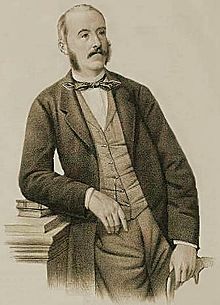Marco Minghetti (November 18, 1818 - December 10, 1886) was an Italian economist and statesman.

Biography
changeMinghetti was born at Bologna into a family of rich landowners. In March 1848 Pope Pius IX offered to him the post of minister in the first constitutional government of the Papal States. However, on 29 April 1848, after the speech with which Pius IX announced the withdrawal of the papal army from the front of the first italian war of independence, Minghetti resigned.
Member of the "Historical Right", he was Minister of the Interior in the governments led by Camillo Benso, Count of Cavour and Bettino Ricasoli. He was also Minister of the Treasury in the government led by Luigi Carlo Farini. He was twice Prime Minister of the Kingdom of Italy: from 24 March 1863 to 28 September 1864 and from 10 July 1873 to 25 March 1876.[1]
In 1864 Minghetti signed the "Convention of September" with France: with this document, Italy renounced in Rome and moved the capital from Turin to Florence. There were many protests against this agreement and consequently Minghetti was forced to resign.[2] During his second experience as President, Minghetti raised taxes to achieve a balanced budget.[3] He was able to accomplish this,[4] but there were protests against his tax policy and was forced to resign for the second time.[2]
Minghetti was the last president of the "Historic Right": after him began the period of the "Historical Left", that remained in power until Francesco Crispi.
Note
change- ↑ 1.0 1.1 Marco Minghetti
- ↑ 2.0 2.1 "Marco Minghetti - Biografia". Archived from the original on 2016-03-05. Retrieved 2015-01-26.
- ↑ "Lectio Minghetti". Archived from the original on 2011-11-01. Retrieved 2015-01-26.
- ↑ "La Destra Storica e i problemi postunitari". Archived from the original on 2015-06-23. Retrieved 2015-01-26.